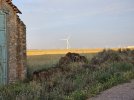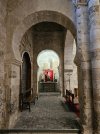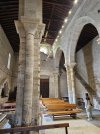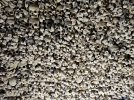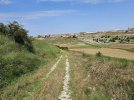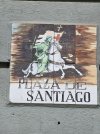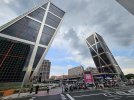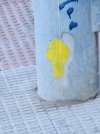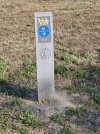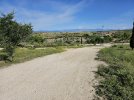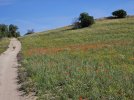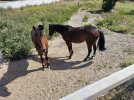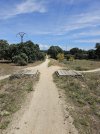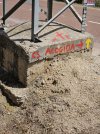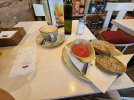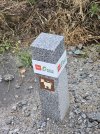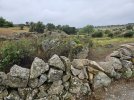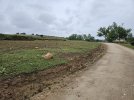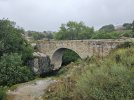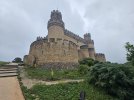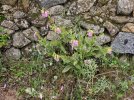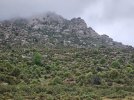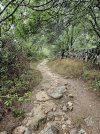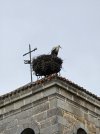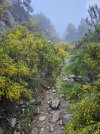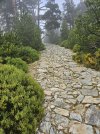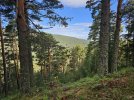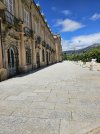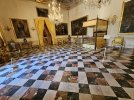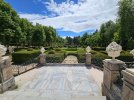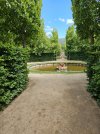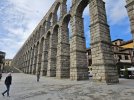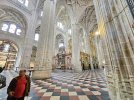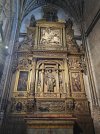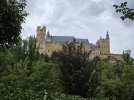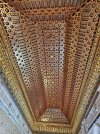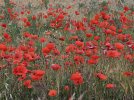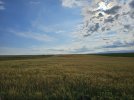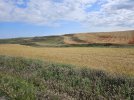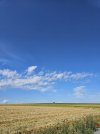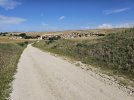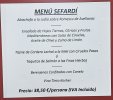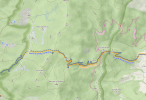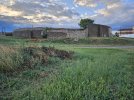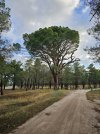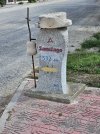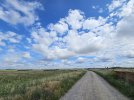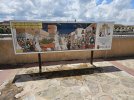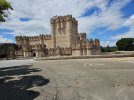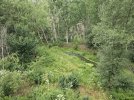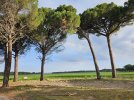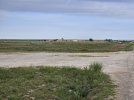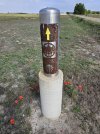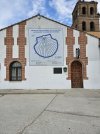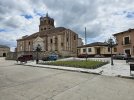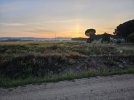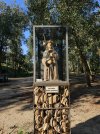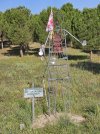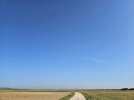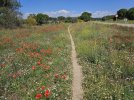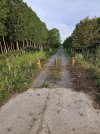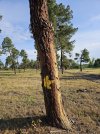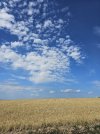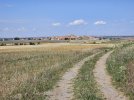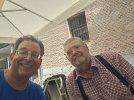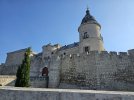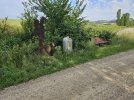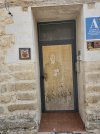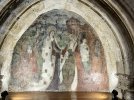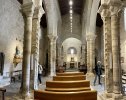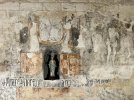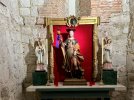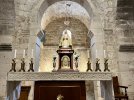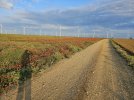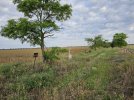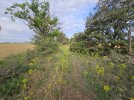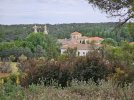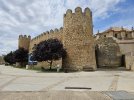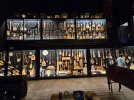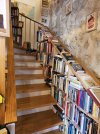Day 13: Ciguñuela to Peñaflor de Hornija
17.64 km
Today was a relatively restful day, too. I got a nice sleep in and left the albergue at 7. As it turns out, it seems as though I wasn't the only one in the albergue. There was someone else spending the night, but he was staying in the room(s) that are off limits to guests. I say he, because I had a brief glimpse of a man who came into the albergue and left, who wasn't very communicative. I assume the person who came back and stayed the night was the same person. In any case, I was out the door and gone before he got up.
Today's walk took me though mostly flat plains where they were farming cereal crops and wind. Yesterday, someone commented on my photo of Cervantes' House asking if I had seen windmills. I hadn't as of yesterday, but today I saw plenty (or, at least, wind turbines, their modern successors). And of course, the usual wildflowers, bunnies, etc.
I got to Wamba at about 8:40, with plenty of time to kill before the church opened to visitors at 11:00. When I arrived the bar was closed, so I headed on over to the church and sat in front of it, using up data on my phone, until about 9:30 when I wandered back to the bar which was just opening. I asked what they had for breakfast and the answer was not much, just coffee and some small packaged cakes. So that's what I had. Later I saw some torreznos (those fried pork fat things I had yesterday) on the counter, but I didn't feel like tackling those two days in a row. At about 10:30 I headed back to the church.
There were now several people waiting and a tour bus had parked nearby. Soon the church doors opened and the guide came out with the group from the tour bus. They headed to the western facade of the church and we were invited to follow them. That was where their tour was ending and ours was beginning. I was invited to leave my backpack and poles in the church.
After she said goodbye to the tour group, the guide let us into the church. Tickets for entry and tour were sold (as a pilgrim, I didn't need one). The tour was in Spanish, and her Spanish was fairly rapid for me, but I certainly got the gist of what she was saying if not every detail. The church was built by the Visigothic kings in the 10th C for and with monks who had come up from Muslim Spain (mozarabes). There had been a large monastery attached, which at one point had occupied the whole plaza.Originally it had been a smaller church and the apse and transept remain from that original Visigothic/Mozarabic church. The horseshoe arches are very typical of that style. In the 12th C the church was handed over to the Order of St. John the Hospitaller. The nave of the church is from that time and is of a late Romanesque style. In the apse and one of the chapels, Mozarabic and Gothic frescos have been rediscovered. Off the cloister/courtyard is an ossuary, one of the largest in Spain, although it is only a fraction of its former size, with many bones having been removed for research and teaching over the centuries. The tour took about half an hour and after that I headed off to Peñaflor de Hornija.
The landscape after the break was much like the landscape before, with the exception that there were a couple of deep valleys that just suddenly appear in the landscape, one of which was just before Peñaflor. So it was quite the climb into the town. There was a phone number in the door, with a note not to call before 2:00. It was a bit after 1:00. So I went to look at the churches and havesome lunch. There are two main churches. One, next to the albergue, is in ruins with only the walls remaining. The other is in active use, and it clearly was being used when I got there, with a mass in progress. I decided not to go in and try and play tourist during the service. Instead, I looked for lunch.
There are two bars in Peñaflor. The first I tried looked good but didn't serve lunch, just bar snacks (rations, like a larger portion of tapas). The other served lunch but suggested I order right away, before mass let out. And I soon could see why as the bar was flooded with people shortly thereafter. First it was the kids and teenagers who headed immediately to where they could get ice cream or chips, obviously an after-mass treat. Then the adults started coming in. Before my first plate arrived, the place was hopping. By the time I left, it was packed, as were all the tables outside in the Plaza. People of all ages, from toddlers (or younger) to seniors. It was clearly the social centre of the village. By this time, of course, the church was locked up tight.
So I headed back to the albergue and called the hospitalera, it being after 2. She said she is also expecting 4 bicigrinos, who called yesterday, but as first to arrive I could have my choice of beds. I picked a nice bed (one of two non-bunk beds, the one with an outlet and light). Then I set about doing laundry. Unfortunately, the washer here is broken so it was handwash again and hope for the best. After laundry and shower, I took to my phone, only to discover that not only is there no wifi (expected) there is no phone signal (unexpected) so I wrote this, which doesn't require signal and then I will have to leave the albergue to try and post it. I say "try" because lack of signal is something I've noticed throughout this village. Worst case scenario, it waits until tomorrow.
Another thing I've been doing, that doesn't require connection, is planning out the rest of my Camino. Normally I love to plan but hate to commit to the plan. But this plan is looking like it will need commitment, at least at the end. It currently has me arriving in Santiago July 25th. If that's going to be the case, I think I am going to need to reserve soon. At least it isn't a holy year.
Here's what it is looking like:
19 days Camino de Madrid June 6 - June 24
3 days
Camino Frances June 25 - 27
(El Burgo Ranero, Mansilla de las Mulas, Leon)
6 days Camino del Salvador June 28 - July 3 ( July 4 with rest day in Oviedo)
11 days Camino Primitivo July 5 - July 16
3 days
Camino Frances July 17-19
5 days Camino Finisterre/Muxia July 24
Back in Santiago July 25, St. James Day
Total: 42 days to Santiago, 43 with a rest day in Ovideo, + 5 to and along the coast and 1 back to Santiago
More immediately tomorrow I am walking to Santa Espina where I will stay the night and am hoping to catch a taxi to visit Urueña. Urueña has been described as follows: "A walled town with 189 residents, but 12 Bookstores and 5 museums. Not to mention walls, history back to Roman times, and the Romanesque Ermita Nuestra Señora de la Anunciada, a beautiful example of Lombard Romanesque." You can see why it would attract me. Unfortunately, it will be Monday when the museums are closed, but the Music Museum has agreed to open for me.
Photos below:
- Wind farm
- Mozarabic transept (Wamba)
- Romanesque nave (Wamba)
- Ossuary (Wamba)
- Heading into Peñaflor de Hornija
